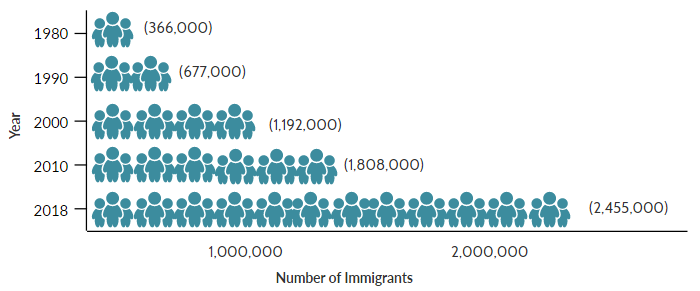PW, you were referring to colleges and universities as potential loci of coronavirus. You were spot on; that's precisely what happened in my town--Tempe, home of Arizona State University, and U.S. nC0V Case #5.
I was looking at immigration statistics the other day. The Chinese are also being hired under work visas in the computer fields.
Chinese Immigrants in the United States
Chinese Immigrants in the United States
JANUARY 15, 2020
By Carlos Echeverria-Estrada and Jeanne Batalova
The population of Chinese immigrants in the United States has grown nearly seven-fold since 1980, reaching almost 2.5 million in 2018, or 5.5 percent of the overall foreign-born population. Whereas in 1980 Chinese immigrants did not appear among the ten largest foreign-born groups in the United States, China in 2018 replaced Mexico as the top sending country. After immigrants from Mexico and India, the Chinese represented the third largest group in the U.S. foreign-born population of nearly 45 million in 2018.
Chinese immigration in the United States has a long and fraught history. Throughout the first half of the 19th century, Chinese manual laborers (predominately men) migrated to the West Coast, where they found employment in agriculture, mining, railroad construction, and other low-skilled jobs. In response to negative public sentiments and organized labor lobbying, Congress in 1882 passed the Chinese Exclusion Act, the first legislation aimed at excluding certain foreigners based on their origin.
Political, economic, and legal developments in both countries during the next half century made it difficult for Chinese nationals either to leave China or to obtain a U.S. visa, stemming subsequent migration flows. The 1965 amendments to the Immigration and Nationality Act removed barriers for non-European immigration to the United States and created temporary worker programs for skilled workers. In contrast, nationals of Hong Kong did not face the same movement barriers as mainland Chinese and began arriving in the late 1960s. Chinese authorities relaxed emigration controls in 1978, and U.S.-China relations were normalized in 1979, beginning a second wave of Chinese migration to the United States.
The number of immigrants from China residing in the United States nearly doubled from 1980 to 1990, and again by 2000. Since then the population continued growing but at a slower pace (see Figure 1).
Figure 1. Chinese Immigrant Population in the United States, 1980-2018*
* Estimates refer to immigrants from mainland China, Hong Kong, and Macau.
Sources: Data from U.S. Census Bureau 2010 and 2018 American Community Surveys (ACS), and 1980, 1990, and 2000 Decennial Census.
The Hong Kong-born population in the United States is far smaller than that from mainland China. There were 80,000 Hong Kong-born immigrants in the United States in 1980, a number that more than doubled to about 204,000 in 2000 and then increased slowly to 233,000 in 2018. Today, Hong-Kong born immigrants make up 10 percent of all Chinese immigrants residing in the United States.
China is the main source of foreign students enrolled in U.S. higher education, and its nationals received the second-largest number of employer-sponsored H-1B temporary visas in fiscal year 2018, after Indians. Chinese nationals received nearly half of EB-5 investor green cards in 2018.
The United States is the top destination for Chinese immigrants, accounting for almost 27 percent of the more than 12 million Chinese living outside of China, according to mid-2019 estimates by the United Nations Population Division. Other popular destinations include Canada (920,000), Japan (785,000), Australia (750,000), South Korea (620,000), and Singapore (451,000).
Click here to view an interactive map showing where migrants from China and other countries have settled worldwide.
Definitions
The U.S. Census Bureau defines the
foreign born as individuals who had no U.S. citizenship at birth. The foreign-born population includes naturalized citizens, lawful permanent residents, refugees and asylees, legal nonimmigrants (including those on student, work, or other temporary visas), and persons residing in the country without authorization.
The terms
foreign born and
immigrant are used interchangeably and refer to those who were born in another country and later emigrated to the United States.
Unless otherwise stated, estimates for China include the People’s Republic of China, Hong Kong, and Macau, but exclude Taiwan.
Compared to the overall foreign- and native-born populations in the United States, Chinese immigrants are significantly better educated and more likely to be employed in management positions. Almost 30 percent of Chinese who obtain lawful permanent residence in the United States (also known as getting a green card) did so through employment-based routes; the remainder qualified through family ties or as asylees.
Using data from the U.S. Census Bureau (the most recent 2018 American Community Survey [ACS] and pooled 2014-18 ACS data), the Department of Homeland Security’s Yearbook of Immigration Statistics, and World Bank annual remittance data, this Spotlight provides information on the Chinese immigrant population in the United States, focusing on its size, geographic distribution, and socioeconomic characteristics.
Click on the bullet points below for more information:
Distribution by State and Key Cities
Roughly half of Chinese immigrants reside in just two states: California (32 percent) and New York (19 percent). The top four counties by concentration in the 2014-18 period were Los Angeles County, CA; Queens County, NY; Kings County, NY; and San Francisco County, CA. Together, these four counties accounted for one-quarter of the overall Chinese-born population in the United States.
Figure 2. Top Destination States for Chinese Immigrants in the United States, 2014-18
Note: Pooled 2014-18 ACS data were used to get statistically valid estimates at the state level for smaller-population geographies. Not shown are Chinese populations in Alaska and Hawaii, which are small in size; for details, visit the Migration Policy Institute (MPI) Data Hub for an interactive map showing geographic distribution of immigrants by state and county,
available online.
Source: MPI tabulation of data from U.S. Census Bureau pooled 2014-18 ACS.
As of 2014-18, the greater New York City, San Francisco, and Los Angeles metropolitan areas had the largest number of Chinese immigrants. These three metro areas accounted for about 43 percent of Chinese immigrants.
Figure 3. Top Metropolitan Destinations for Chinese Immigrants in the United States, 2014-18
Note: Pooled 2014-18 ACS data were used to get statistically valid estimates at the metropolitan statistical-area level for smaller-population geographies.
Source: MPI tabulation of data from U.S. Census Bureau pooled 2014-18 ACS.
Table 1. Top Concentrations by Metropolitan Area for Chinese Immigrants, 2014-18
Source: MPI tabulation of data from the U.S. Census Bureau pooled 2014-18 ACS.
Click here for an interactive map that highlights the metropolitan areas with the highest concentrations of immigrants. Select China from the dropdown menu.
English Proficiency
Chinese immigrants are less likely to be proficient in English and speak English at home than the overall U.S. foreign-born population. In 2018, about 58 percent of Chinese immigrants ages 5 and over reported limited English proficiency, compared to 47 percent of the total foreign-born population. Approximately 11 percent of Chinese immigrants spoke only English at home, compared to 17 percent of all immigrants.
Note: Limited English proficiency refers to those who indicated on the ACS questionnaire that they spoke English less than “very well.”
Age, Education, and Employment
On average, Chinese immigrants are of similar median age compared to the overall foreign-born population (median age of 45 years)—and both groups are older than the U.S.-born population (36 years). In 2018, Chinese immigrants were slightly less likely than the overall foreign-born population, but more likely than the native-born population, to be of working age (18 to 64; see Figure 4).
Figure 4. Age Distribution of the U.S. Population by Origin, 2018
Note: Numbers may not add up to 100 as they are rounded to the nearest whole number.
Source: MPI tabulation of data from the U.S. Census Bureau, 2018 ACS.
Click here to view an interactive chart showing the age and sex distribution of top immigrant groups, including the Chinese born.
Chinese immigrants have considerably higher levels of educational attainment, especially in terms of advanced degrees, compared to the overall foreign- and U.S.-born populations. In 2018, about half of Chinese ages 25 and over had at least a bachelor’s degree, significantly higher than among immigrants overall and U.S.-born adults (32 percent and 33 percent, respectively). Notably, Chinese immigrants were more than twice as likely to have a graduate or professional degree compared to the other two groups (29 percent compared to 14 percent for all immigrants and 12 percent for the U.S. born).
This high educational attainment is linked to the specific channels through which Chinese immigrants enter the United States. In recent decades, many Chinese immigrants arrived either as international college students or high-skilled H-1B temporary workers (generally requiring a university degree). China is the leading sending country of international students in the United States: In the 2018-19 school year, close to 377,000 students from mainland China, Hong Kong, and Macau were enrolled in U.S. higher education institutions, according to the Institute of International Education. They accounted for about one-third of the 1 million international students studying in the United States. Approximately 46 percent of Chinese students were enrolled in science, technology, engineering, and math (STEM) fields. In FY 2018, Chinese citizens represented 12 percent of the 332,000 H-1B petitions (initial and continuing employment) approved by U.S. Citizenship and Immigration Services (USCIS), outnumbered only by Indian nationals, who accounted for 73 percent of those petitions.
Chinese immigrants participate in the labor force at a lower rate than the overall immigrant and native-born populations. In 2018, almost 60 percent of Chinese immigrants ages 16 and over were in the civilian labor force, compared to 66 percent and 62 percent of the total foreign- and native-born populations, respectively. More than half of Chinese immigrants were employed in management, business, science, and arts occupations versus 33 percent of the overall foreign-born and 40 percent of the native-born population.
Figure 5. Employed Workers in the Civilian Labor Force (ages 16 and older) by Occupation and Origin, 2018
Source:MPI tabulation of data from the U.S. Census Bureau 2018 ACS.
Income and Poverty
In 2018, Chinese immigrants had higher median household incomes compared to the overall foreign-born population: $70,000 compared to $60,000 (and $62,000 for native-born households)
Chinese immigrants were slightly more likely to live in families with annual incomes below the official poverty threshold (17 percent) compared to immigrants overall (15 percent) or the U.S. born (13 percent).
Immigration Pathways and Naturalization
In 2018, 53 percent of all Chinese immigrants in the United States were naturalized U.S. citizens, a share slightly higher than for the overall foreign-born population (51 percent).
Compared to all immigrants, Chinese immigrants are more likely to have arrived in the United States recently. Thirty-four percent of Chinese immigrants arrived in 2010 or later. Another 24 percent arrived between 2000 and 2009, and 42 percent before 2000 (see Figure 6).
Part 1 of 2

















 I'm not overly concerned because I do have my stash but thought I'll pickup a few more. Nope- went to Walmart, 2 dollar stores, 3 Walgreens, Smith's, and CVS. not a mask to be found.
I'm not overly concerned because I do have my stash but thought I'll pickup a few more. Nope- went to Walmart, 2 dollar stores, 3 Walgreens, Smith's, and CVS. not a mask to be found.













